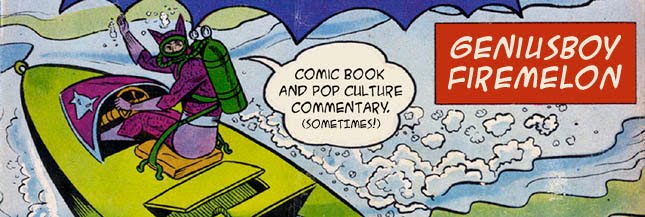 I have a lot of smart readers, so I'm going to throw out a comics-related question that I truly don't know the answer to. If you know the answer, or know where to find it, please let me know!
I have a lot of smart readers, so I'm going to throw out a comics-related question that I truly don't know the answer to. If you know the answer, or know where to find it, please let me know!Here's the set-up and then the question. In the final issue of "The Great Darkness Saga," originally published in The Legion of Super-Heroes #294 (December 1982), Paul Levitz includes over 50 (I count 51, but I'm sure I'm missing a few) different characters from the DC Universe (not including all of the unnamed characters in the issue, like the Daxamite army and the floating dead bodies around the galaxy). A few years later (1985) Crisis on Infinite Earths #1 surely had more characters than that. So my question is Was Levitz the previous record holder for most characters in a single issue?
Did any comic book have more than 51 significant characters in any issue before December 1982? If so, what issue of what comic? How many characters appeared?
I want to know these things.

9 comments:
What about the famous Bouncing Boy/Duo Damsel wedding scene?
Good call, although I guess I was thinking about "Single issue with the most characters who played an active role," rather than "Single issue with most characters in the background just standing there."
Okay, I just went back to check on that wedding issue, and even with all of the characters attending the wedding, I still only count about 45 different characters in the issue. What's your count?
Uh... I don't know; I don't have it in front of me. I could check tonight.
But it depends on whether you draw a distinction between 'in the background just standing there' and 'in the background of a fight scene'. Background is background, after all; just because someone took a swing at a Daxamite doesn't mean they had a major role in the story.
Some of the JLA/JSA crossovers probably had a lot of characters. Maybe even the one with the Legion. Of course, they did tend to only use five to seven members from each team...
But if standing-in-the-background is okay, there's also LSH #300.
Or that issue of All-Star Squadron where they had their first big meeting, and it starts off a crossover with the Freedom Fighters. That had to have a lot of characters in it.
I need numbers of character, Matthew! NUMBERS! Give me some answers, oh wise Legion expert.
I'm at work! I'll get back to you tonight.
Okay.
I agree with your count of 45 in the BB/DD wedding story.
All-Star Squadron #31 has 52 characters with speaking parts (or as good as speaking parts), and none of them are just faceless extras. In addition, there are visual references to nine other superheroes (plus the Blackhawks, on top of those nine!) who do not appear in the story, but they're pictured and they have definite identities. If we count them that takes us up to 66. (Creative team: Roy Thomas and Rick Hoberg; cover-date Mar '84.)
LSH #300 is of course a selection-of-little-stories issue, with a big everyone-smile-for-the-camera two-page splash at the end, so it's kind of a cheap way to qualify. Still: there are 68 characters in the big splash at the end, in addition to the characters who appear in the body of the issue (Lana Lang, Pete Ross, Luthor, Invisible Kid I, Cosmic King, Saturn Queen, Lightning Lord, Computo, the Fatal Five, Chemical King, Tyroc, Mordru, the Dark Man, Douglas Nolan and Queeg). Of course, among the 68 in the end splash are characters like Garfield, Batman, Spider-Man and some DC staffers, so we'd probably want to winnow some of those out. So something less than 87 characters. And, of course, #300 takes place *after* #294.
I also thought of the JLA / JSA team-ups, but can't come up with a specific case. I think the point here is that "The Great Darkness Saga" featured a hell of a lot of characters, and it's an interesting argument to claim that the proliferation of Legion characters, and the joy the series took at that (in contrast to so many others [e.g. "What are we going to do with 13 X-Men?"] and particularly in the Levitz years) could be seen as a forerunner to the "everyone and the kitchen sink" model of "Crisis on Infinite Earths."
True. But I'm always willing to ignore the forest and concentrate on the trees.
Post a Comment